EARTHQUAKE in PAKISTAN, ASIA - 8 October 2005
As many as 54,000 people are feared dead and millions have been left without shelter when a severe earthquake hit areas of Pakistan, India and Afghanistan early on 8 October.
The epicentre of the quake, which measured 7.6 on the Richter scale, was some 95 kilometres north of Pakistan’s capital city Islamabad. Several villages are known to have been completely destroyed, and countless others have been severely damaged.
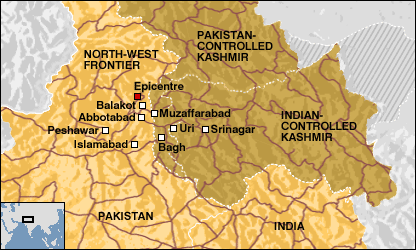
Quake appeal raises fresh $580m
International donors have pledged $580m
(£327m) of new funds to help victims of
the South Asia earthquake, after warnings
of an impending catastrophe.
The promises followed a UN appeal for a
huge increase in funds - though the body
said too little of the new cash had been
earmarked for sole UN use. The UN says more resources are needed
to save more than 3m people in mountain
villages who lack food and shelter.
Secretary General Kofi Annan said a
"winter without pity" was
looming.
Relief workers say they face a race
against time to provide shelter and food
stocks for hundreds of thousands of people
in Pakistani-administered Kashmir. "All humanitarian organisations
are acutely aware that our window of
opportunity for action is closing with the
onset of the severe winter," UN
relief coordinator Jan Egeland said in a
statement in Geneva.
As if to underline the problems, bad
weather grounded the vital international
helicopter aid fleet at the main airbase
near the Pakistani capital, Islamabad, on
Wednesday.
New aftershocks also sparked fears of
more landslides in the quake zone. There
have been more than 970 such shocks
following the 8 October disaster.
'Reconstruction money'
Before the donors' conference began in
the Swiss city, less than 30% of the UN's
original target of $312m had been pledged,
the UK-based charity Oxfam noted. But other aid pledged to Pakistan
outside the remit of the UN had brought
the total to more than $700m. That was
before the further pledges by the end of
the day.
Mr Egeland said the puprose of much of
the money promised had not been specified.
"The good news is that we have
very good pledges, but the bad news for us
is that too little is committed to the
UN's flash appeal," he told
reporters. About half of the new money is being
supplied by Islamic countries, the UN
said.
'New wave'
Mr Annan told the conference in Geneva
that there was still time to stop a wave
of "deaths and despair caused by
freezing temperatures and disease, by lack
of shelter, food and water".
Pakistani President Pervez Musharraf
has said the financial cost of the quake
will be more than $5bn.
Before the conference opened, Oxfam
suggested that some Western countries had
given less than their "fair
share" to the UN appeal as large
economies. "The logistical nightmare in
Pakistan is bad enough without having to
worry about funding shortfalls as
well," said Oxfam policy director
Phil Bloomer. But countries which have not pledged
cash sums to the UN appeal have been
helping in other ways, such as through the
Red Cross.
France, for instance, has donated $9m
to various aid bodies including the Red
Cross and provided personnel for a Nato
mission. "It doesn't mean we won't
give to the UN appeal at some point but at
the moment we are happy with the
structures we are working within,"
Vincent Floriani, a French embassy
spokesman in London, told the BBC News
website.
"We may not be the biggest donor,
but we feel we are doing our bit."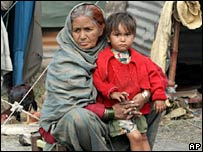
HOW TO DONATE
Unicef
UNHCR
Disasters Emergency
Committee (UK)
World Food Programme
Kashmir International
Relief Fund
Red Cross/ Red Crescent
IOM
Donate
to support our South Asia Children's Earthquake
Fund
Approximately
3 million people are without shelter after the
deadly earthquake. Save the Children is working
to deliver tents, blankets and other basic
supplies to children and families in impacted
areas.
Westport,
CT (October 24, 2005) -
To
make a payment by check, please send to
Save the Children,
Oxfam
is rushing tents, blankets, and other urgently
needed relief aid to affected areas of Pakistan
and India. We have also sent in teams to assess
longer term needs. Get
the latest updates on the situation from Oxfam.
South
Asia Earthquake: Diaries Read
first-person accounts from Pakistan, where Oxfam
has been working round the clock.
The 8 October South Asian earthquake
killed at least 17,000 children when their
schools collapsed, the UN children's fund,
Unicef, says.
It said those that survived were either
injured or suffered the trauma of losing friends
and teachers. It also warned of a second wave of deaths if
children did not get health care, clean water
and immunisations. Pakistan says the quake killed more than
55,000 people, injured another 78,000 and left
three million homeless. Another 1,300 died in Indian-administered
Kashmir.
Unicef says Pakistan government estimates
show 6,700 schools were destroyed in North-West
Frontier Province and 1,300 in
Pakistan-administered Kashmir as children
attended morning classes.
Ann Veneman, Unicef executive director, said
the trauma suffered by the children who survived
could well be worse than those who escaped last
December's Asian tsunami.
"The ones that survived, many have
injuries. The ones that survived, also many lost
friends. They lost teachers, they lost important
people in their lives." Unicef estimates nearly 20,000 children
"will have physical impairments after this
tragedy due to injuries and amputations".
Tents pledge
Ms Veneman also said there was a continuing
threat to the wellbeing of the survivors.
"We are concerned about the possibility
of a second wave of loss of life if children
don't get the right interventions." Ms Veneman repeated appeals for more aid from
the international community, saying it had only
provided a fraction of what was needed.
The UN has asked for $550m but has so far
received pledges of only $327m. The UN is leading a massive relief effort to
try to get aid to the millions of people
affected before the harsh Himalayan winter sets
in. On Monday, Pakistani President Pervez
Musharraf vowed to deliver 500,000 tents by the
end of November.
Relief groups say about 800,000 people still
lack shelter. President Musharraf defended the relief
effort. "I am fully confident that we will meet
the challenge and I will prove the cynics
wrong," he said. Pakistan also said it had set up two relief
camps on the Line of Control that separates
Indian and Pakistani-controlled Kashmir. India
has set up three on its side.
The move came after the nations agreed on
Saturday on a landmark opening of the Line of
Control to help quake victims. Relief items can be sent in both directions
and families will be able to cross at five
points from 7 November - but only on foot. No
vehicle crossings will be allowed. People wanting to cross will need a permit
from government officials on either side.
Experts have long been warning of the
danger of serious earthquakes in South Asia -
and say more are likely.
Many have struck along the southern flanks of
the Himalayas over past centuries - but not
enough to account for all the steady, northward
movement of India into Asia. The earthquake in Pakistan is the result of
India's long-term, gradual, geological movement
north into Asia at a speed of five centimetres a
year - a millimetre per week.
Earthquakes happen when energy stored up
along geological faults, like the Himalayan
thrust, is suddenly released. The trouble is, the more time passes without
seismic release, the more energy accumulates,
making a giant earthquake more likely. The latest earthquake fits in with the
scientists' expectations but, at 7.6 on the
Richter scale, is relatively weak compared to
what they feared.
Nevertheless, it is likely to have been very
destructive - the 2001 earthquake in the western
Indian state of Gujurat was of a similar
strength and killed 14,000 people. But earthquakes tens of times more powerful
must be expected, the experts warn - and could
kill as many as a million on the Ganges plain.
What scientists cannot say is when the next
one will strike - and that makes it far more
difficult for them to convey their warning.
The
2004 Indian Ocean earthquake, known by
the scientific community as the Sumatra-Andaman
earthquake, was an undersea earthquake
that occurred at 00:58:53 UTC (07:58:53 local
time) on December 26, 2004. The tsunami
generated by the earthquake killed approximately
275,000 people, making it one of the deadliest
disasters in modern history. The disaster is
also known as the Boxing Day Tsunami.
LINKS
:
Struggle
for normality
EYEWITNESS
BACKGROUND
![]()
Save the Children is calling on the United
States government to mobilize more international
support to avoid “a catastrophe to children of
unimaginable proportions” now unfolding in the
frigid mountainous regions of northern Pakistan
struck by an earthquake two weeks ago.
“Tens of thousands of children who managed to
survive one of the deadliest earthquakes in
modern times may soon freeze to death or die
from their injuries unless help comes soon,”
said Charles MacCormack, President and CEO of
Save the Children, based in Westport, CT.
54 Wilton Road, Westport, CT 06880. Make check
payable to Save the Children and write “South
Asia Children's Earthquake Fund” in the memo
section or indicate if you would like the
donation to go to our general fund.

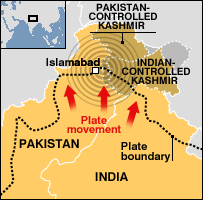
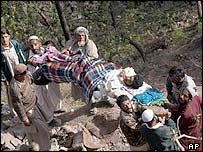
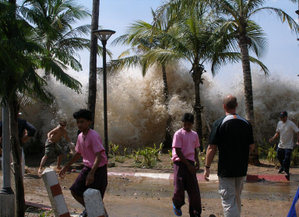
TV
news reports
![]()
![]() 'Law
of the jungle'
'Law
of the jungle'
Despair
and panic reign in remote Neelum Valley, reports
Aamer Ahmed Khan.
![]()
STORMS
| HURRICANES
| TORNADOES |
ATMOSPHERE
| WATER CYCLE |
FORECASTING
![]()
CONTACT
SOLAR NAVIGATOR
This website is Copyright © 1999 & 2005 NJK. The bird logo and name Solar Navigator are trademarks. All rights reserved. All other trademarks are hereby acknowledged. Max Energy Limited is an environmental educational charity.
BLUEBIRD ELECTRIC CAR MANUFACTURERS ELECTRIC CARS ELECTRIC CYCLES SOLAR CARS